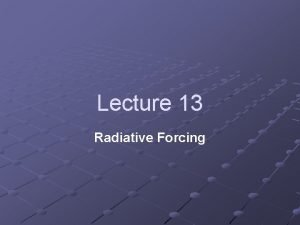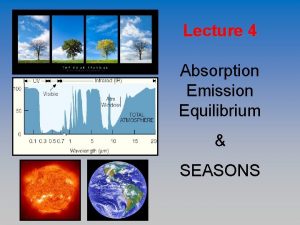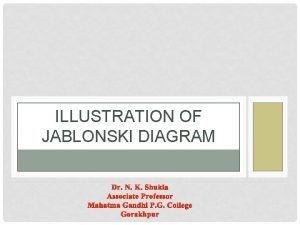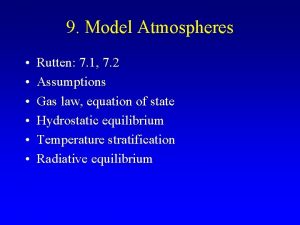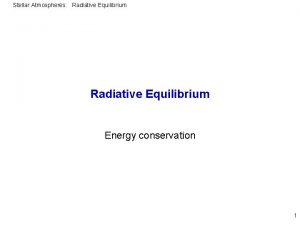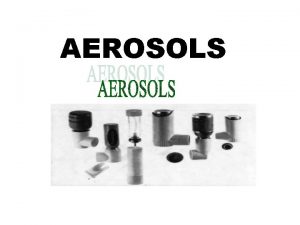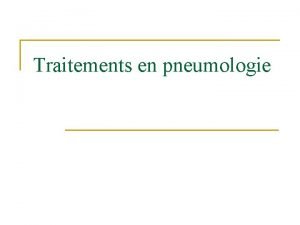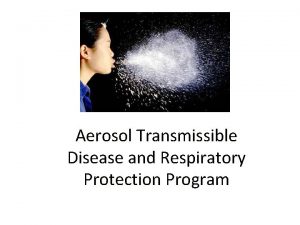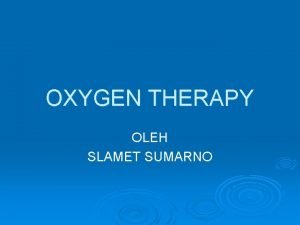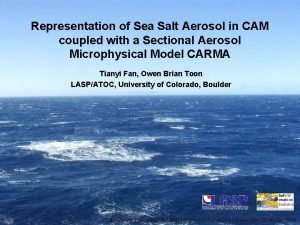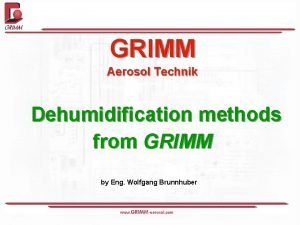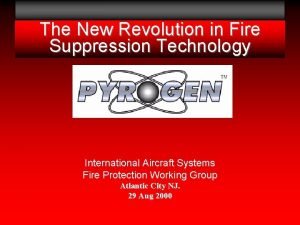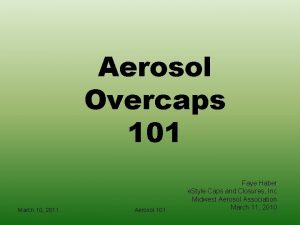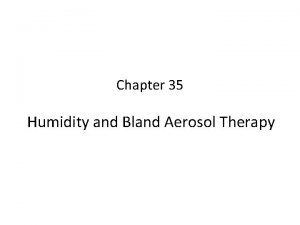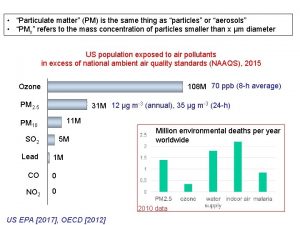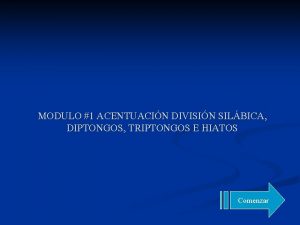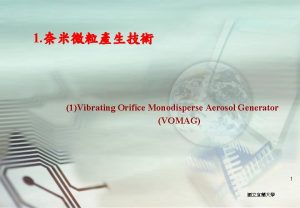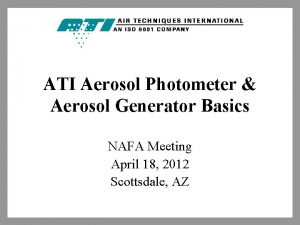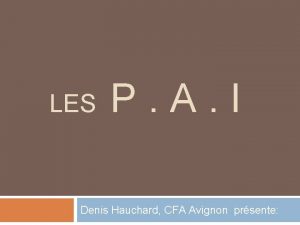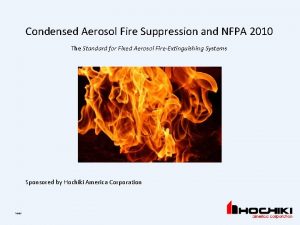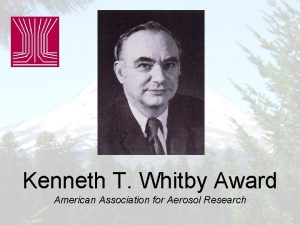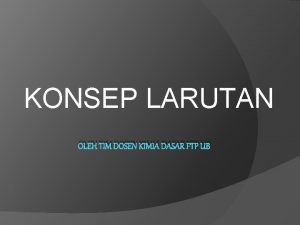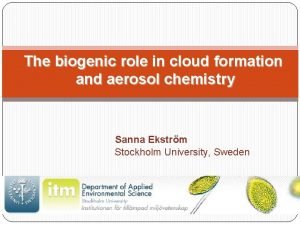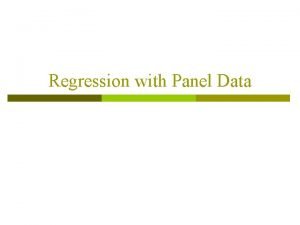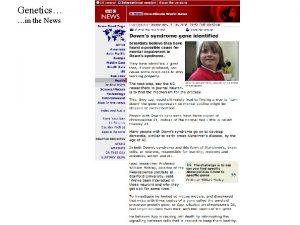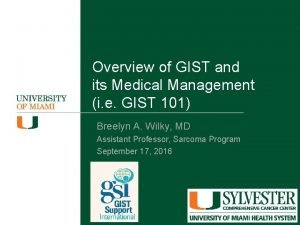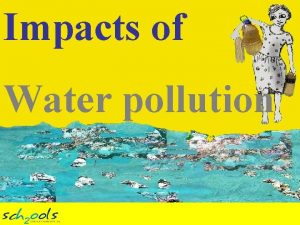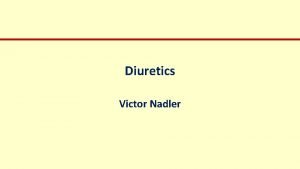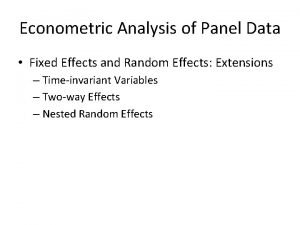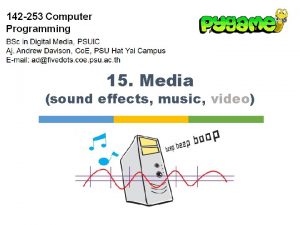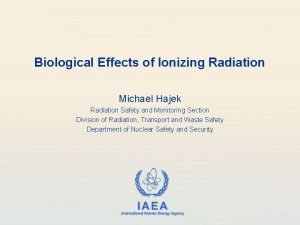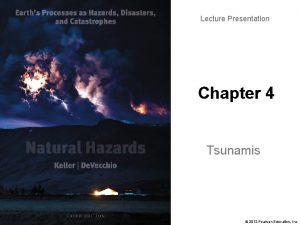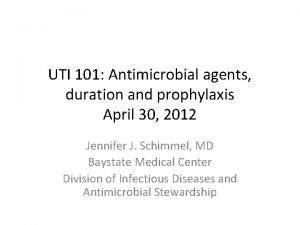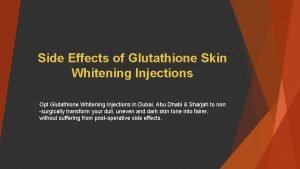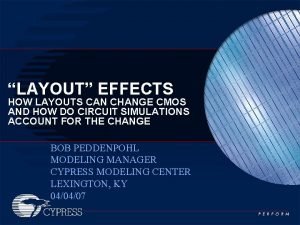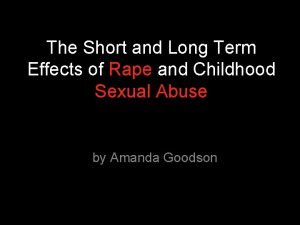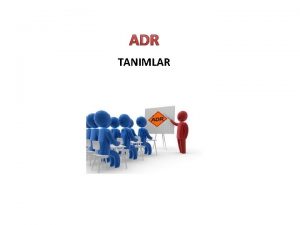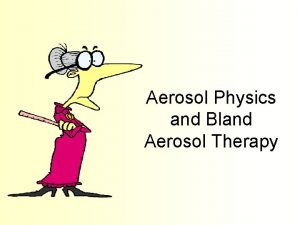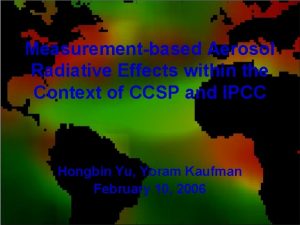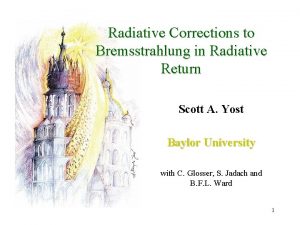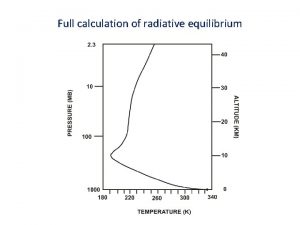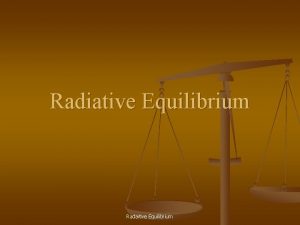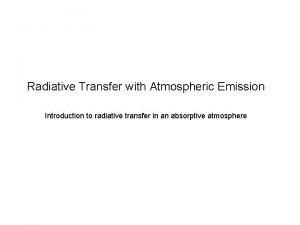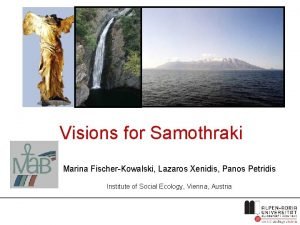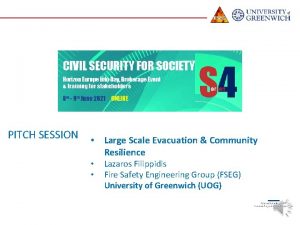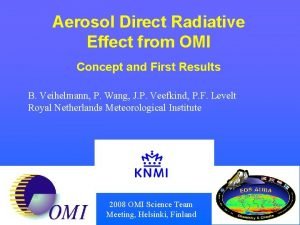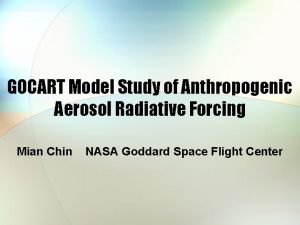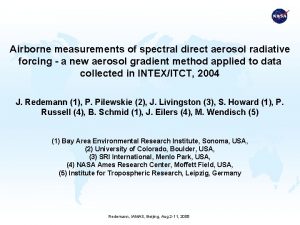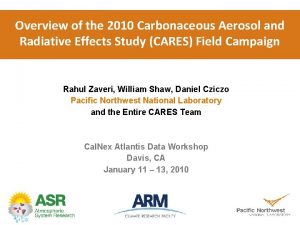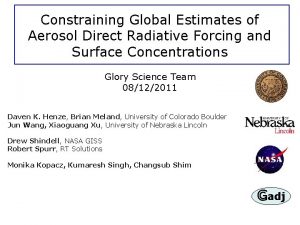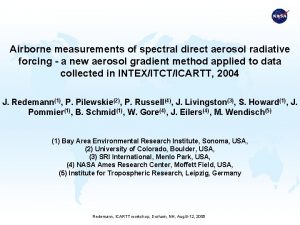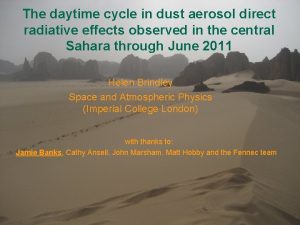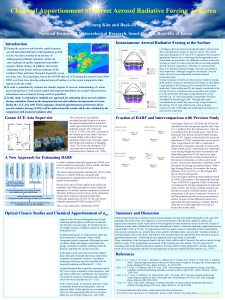Lazaros Oreopoulos aerosol radiative effects with MACv 2


















































- Slides: 50

Lazaros Oreopoulos aerosol radiative effects with MACv 2 Stefan Kinne MPI-Meteorology

outline • what are MACv 2 aerosol direct rad. effects ? • direct radiative effects by component • anthropogenic contributions • how does anthrop. aerosol influence climate ? • indirect (via clouds) impacts • direct vs indirect (via clds) impacts (over time) • dimming and brightening by anthrop. aerosol

my aerosol research began with TOM • hhh …introduced me to aerosol and log-normal size distributions 30 years ago background aerosol: sulfate, mode rad: 0. 08 um, std. dev 1. 8

so I assumed component properties

apply to MACv 2 optical properties Aerosol <1 um AODf 50% AAODf 70% (10 times) Aerosol > 1 um AODc 50% AAODc 30% (10 times)

component AOD 550 nm • < 1 um organic soot OC+BC sulfate • • OC BC CA SU • > 1 um dust • DU seasalt • SS . 037 SU . 031 DU . 022 OC . 028 SS 10*times . 026 CA . 004 BC

component TOA forcing AOD • < 1 um organic • OC soot • BC OC+BC • CA sulfate • SU • > 1 um dust seasalt • DU • SS 0. 1*times +. 25 DU -. 45 OC -. 55 SS -. 80 SU +. 55 BC cooling (net-flux loss) +. 08 CA (net-flux gain) warming

anthr component TOA forcing anthrop AOD 550 nm - 50% of AODf - 25% of AOD - uncertain -. 40 SU • < 1 um organic soot OC+BC sulfate • • OC BC CA SU -. 22 OC +. 44 BC cooling (net-flux loss) . +. 05 CA (net-flux gain) warming

TOA forcing efficiencies (/ AOD) • total (sol+IR) anthropog. clear -sky - 24 all -sky - 12 cooling (net-flux loss) (net-flux gain) warming

indirect too ? • yes … there is also an aerosol indirect effect • via modified clouds • extra anthropogenic aerosol tends to increase cloud droplet concentrations • as more nuclei compete for the same water (at condensation) cloud droplets are smaller • how • extract potential from satellite observations of – AOD of <1 um sizes: aerosol number – CDNC at cloud top: droplet number

the indirect ‘relationsship’ • AODf vs CDNC satellite fit AODf model param CDNC

extract CDNC / radius - change d (CDNC) v v P I P D d(drop-radius) = 1/ {d(CDNC)**(1/3)} if LWC unchanged

direct vs indirect (TOA) today anthropogenic • at TOA: indirect is larger (on average) indirect clear-sky -. 66 direct + indirect all-sky -. 35 cooling (net-flux loss) warming

direct vs indirect (atmos) today anthropogenic • for atmos: only direct matters indirect clear-sky + 0. 0 direct + indirect all-sky + 1. 1 cooling (net-flux gain) warming

direct vs indirect (surface) today anthropogenic • at surface: direct dominates indirect clear-sky -. 66 direct + indirect all-sky - 1. 4 cooling (net-flux loss) warming

to remember • there is a lot of spatial variability to aerosol rad. effects, which global averages do not capture – still when using global averages… • the TOA forcing efficiency is at -12 W/m 2 /AOD • cooling co-emitters reduce BC mitigation pot. • direct and indirect effects cool - but differently • anthropogenic effects (today) … in W/m 2 dominant • TOA: -. 67 DIR clr ) -. 35 (DIR all ) -. 66 (IND) - 1. 0 (tot) • atm: +1. 1 (DIR clr ) +1. 1 (DIR all ) +. 00 (IND) + 1. 1(tot) • surf: - 1. 7(DIR clr ) - 1. 4 (DIR all ) -. 66 (IND) - 2. 1 (tot)

… back to TOM • Tom • always impressed/s with clear presentations • was/is always outspoken … with strong (‘Lutheran’) opinions • has a soft / caring core • among all his accomplishments … (that counts most) … is his family • so if we celebrate TOM, we also celebrate Linda and his family ! • … and I was lucky enough as I became part of it … 30 years ago!

TOM & family

extras

MACv 2 • Max-Planck Aerosol Climatology version 2 • merging of observations and modeling (. 55 um) • monthly (1 x 1 lon/lat) gridded global maps for • • • aod, ssa, asy (at any wavelength) CCN (IN) estimates component mixture (BC, OC, SU, SS, DU) altitude distribution anthropogenic attribution temporal (anthropogenic) change – ftp: //ftp-projects. zmaw. de/aerocom/climatology/MACv 2_2018/

O y t i l ua AOD, 550 nm amount AAOD, 550 nm absorption (10 times) the merging Co nte x t AODf, 550 nm size reff, fine size

updates in Version 2 • more recent AERONET data are included • (multi-year) reference year 2005 (not 2000) • MAN data over oceans are now included • better coverage for AOD and AODf • a new data merging (regional) procedure • stronger AERONET/MAN data weight • only absolute properties are merged • e. g. AAODf, AAODc instead of SSA • pre-defined aerosol types for are applied • spectral dependencies via component AODs • new anthropogenic assignment • now lower - based on IPCC 5 emissions

optical properties amount & absorption … by size AODf AODc AAODf AAODc (10 times) (10 times) fine-mode coarse-mode

anthropogenic • only contributions to submicrometer (fine-mode) sizes • based on fine-mode fraction scaling factors by bottomup Aero. Com modeling • AC 1 with Aero. Com 1 emissions ( MACv 1) • AC 2 with Aero. Com 2 emissions ( MACv 2) uncertainties directly affect climate impact estimates annual AOD 550 nm maps total 2005 anthropogenic 2005 as in MACv 1 33% 26% anthropogenic, 2005 as in MACv 2

component mixture MACv 2 distributed on pre-defined ‘components’ • fine-mode • OC • BC (coated) • SU (non-abs) AOD 550 nm 10*times • coarse-mode • DU • SS anthropogenic dust (via Ginoux) shown for comparison 10*times BC and ant-DU multiplied by 10

altitude distribution • based on scaling factors (multiplied fine AOD >6 to MACv 2 column km asl AOD) by bottom- 3 -6 up modeling for km asl • fine-mode AOD • coarse-mode AOD alternate scaling with CALIPSO 1 -3 km asl 0 -1 km asl coarse AOD

temporal change • natural (coarse-mode + PI fine-mode) unchanged • anthr change • based on scaling via bottom-up • 1850 -2100 • • • 1865 1885 … 2065 2085

MACv 2 summary • today’s global column properties here at – AOD (aerosol optical depth: column amount) • 0. 122 (total) 0. 058 (coarse). 030(DU). 028(SS) 550 nm 0. 063 (fine). 022(OC). 04(BC). 037(SU). 031 (anthropogenic) – SSA (single scattering albedo: column absorption) • 0. 941 (total) 0. 964 (coarse) 0. 919 (fine) – ASY (asymmetry-factor: angular scattering behavior) • 0. 70 (total) 0. 77 (coarse) 0. 64 (fine) • strong spatial and temporal variability • captured by 1 x 1 lat/lon monthly maps

direct radiative effects • impacts of the aerosol (or added) presence on the radiative energy distribution in atmosphere • apply dual calls in offline radiative transfer with and without (or with less) aerosol and then look at netflux-changes – at TOA (overall climate impact) – at surface (impact on surface processes) – for atmosphere (impact on dynamics) • in the focus • today’s total aerosol • today’s component aerosol components • today’s anthropogenic contributions

the setup ISCCP (H/M/L) cloud cover • the radiative transfer model • • 8 solar / 12 IR bands two-stream model 9 diff sun-elevations 8 cloud permutations alt(km)/10 high MODIS vis mid MODIS n. IR low • the monthly input • • MACv 2 aerosol ISCCP clouds MODIS sp. albedo standard profiles • the output • rad. netflux changes

scenarios • no clouds (clear-sky) • better comparable to observations • with clouds (all-sky) • climate relevancy • focus on TOA and surface impacts • atmospheric impacts by diff (TOA minus surface) • focus on total and solar (SW only) impacts • infrared (LW) impacts by diff (total minus solar ) • anthropogenic contribution • solar (SW) impacts only matter

direct effects • total (sol+IR) (today, annual) total (solar only) anthropog. TOA clear surf clear TOA all 10*times surf all cooling (net-flux loss) (net-flux gain) warming

forcing efficiencies (/ AOD) • total (sol+IR) total (solar only) anthropog. TOA clear surf clear TOA all surf all cooling (net-flux loss) (net-flux gain) warming

comp. TOA effects total (in W/m 2) • DU • +0. 02 ant • SU • OC • BB comp ant-com • +0. 25 - 0. 25 sol +0. 50 IR • SS (today, annual) 0. 1*times • -0. 55 • -0. 80 • -0. 40 ant 0. 1*times • -0. 45 • -0. 22 ant • +0. 55 • +0. 25 to +0. 44 ant climate cooling climate warming

comp. TOA efficiencies (/AOD) • all-sky FE /AOD E • in W/m 2 /AOD – SS -20 (-18) – SU -22 (-21) – OC -20 (-19) – DU +8 (-5) – BC +130 – CA +3 (+150) (+8) • using global avg forcing and AOD • FE spatial avg 0. 1*times

direct summary • direct effect (today) • TOA: -1. 1 (total) • surf: -4. 0 (total) … in W/m 2 -1. 8 sol /+0. 7 IR -5. 5 sol /+1. 5 IR • component TOA effects • • • BC: +. 55 (total) DU: +. 25 (total) SU: -. 80 (total) OC: -. 45 (total) CA: +. 08 (total) SS: -. 55 (total) -0. 35 (anthrop) -1. 5 (anthrop) … in W/m 2 +. 25. . +. 45 (ant) +. 02 (anthrop) -. 40 (anthrop) -. 22 (anthrop) +. 05 (anthrop) what is ant-BC ? ant-DU small main ‘cooler’ OC+BC ~ neutral not anthrop

aerosol and climate • part of today’s aerosol is anthropogenic • 20 -33% of today’s global average AOD • > 50% of today’s global mean aerosol number • two main impacts on to consider • added presence in the atmosphere (DIRECT) • aerosol modified water clouds (INDIRECT) • indirect effects ? • aerosol provide nuclei on which droplets grow – smaller droplets at water condensation + higher planetary albedo, delayed precipitation - faster evaporation at dry air entrainment.

indirect assumptions • only water drop size reductions matter • cloud-lifetime effects are secondary – MODIS retrievals identify reduced drop sizes but no significant changes to water content with Iceland volcano sulfate over the Atlantic • apply satellite regional microphys associations • • use ‘observations’ … rather than model parameteriz. use large scale stats … exaggeration at small scales use fine mode AOD for aerosol concentration use ‘good’ CDNC … overcast, ocean, no-side views • regionally associate (diff sensors: MODIS, ATSR)

indirect – on planetary albedo • impact is strongly influenced by environment ! • • sun clouds altitude surface seasonality ! over oceans ! cooling (net-flux loss)

today’s aerosol indirect effect • solar impact dominates -. 70 W/m 2 cooling • IR impacts are small - especially at TOA solar IR TOA surface cooling (net-flux loss) (net-flux gain) warming

direct vs indirect

dimming / brightening at surface • 1905 - 1865 • 1945 -1905 • 1985 -1945 • now -1985 direct/clear direct/all direct + ind

retrieval model by MACv 2 • assume a simple 4 component model • • fine-mode strong absorbing type fine-mode scattering type coarse-mode strong absorbing type coarse-mode scattering type • MACv 2 (AODf, AODc, AAODf, AAODc) defines • fractional contributions for fine-types • fractional contributions for coarse types • fractional contributions of fine-mode and coarse-mode by AOD – for any loc / month COMPOSITION defined

ingredients • MACv 2 defines – AODc – AODf – AAODc, – AAODf • ICAP defines – FMF as function of AOD

bi-modal distribution fine-mode • Reff =. 145 um coarse-mode • Reff = 1. 9 um – based on AERONET statistics

scatt & abs ‘extreme’ types • prepare LUT for 4 log-normal distributions • fine – r, m =. 096, sdev. 1. 5; RI, im = 0. 0 ( SSA=1) – r, m =. 096, sdev. 1. 5; RI, im = 0. 05 ( SSA=. 77) • coarse – r, m =. 97, sdev. 1. 7; RI, im = 0. 0 ( SSA=1) – r, m =. 97, sdev. 1. 7; RI, im = 0. 01 ( SSA=. 74)

local fraction per size mode • MACv 2 • prescribes the absorbing type fractions for – fine-mode – coarse-mode • the remaining fraction goes to ‘scattering’ type

FMF (as function of AOD) • FMF – for different AOD ret / AOD MACv 2 factors • • 2. 5 2. 0 1. 6 1. 25. 8. 625. 5. 4

concept for an retrieval • assume the local MACv 2 fine-mode fraction • define- and coarse-mode fraction according to mode absorption by MACv 2 • retrieve an AOD and compare to MACv 2 value • based on AOD diff pick an improved fine fraction • retrieve the eventual AOD – all needed monthly 1 x 1 global maps are on ftp: //ftp-projects. zmaw. de/aerocom/climatology/ MACv 2_2018/retrieval/ read the README file

outlook • quantify variablity • (monthly) PDFs in place of averages • accounting for associations (e. g. AOD AAOD) • use more / better observations • consider spatial context from assimilations of satellite data • use active remote sensing to for AOD alt-distr. • apply updated / more photometer data • address uncertainty • via sensitivity studies
 Radiative forcing definition
Radiative forcing definition Radiative equilibrium temperature
Radiative equilibrium temperature What is the jablonski diagram
What is the jablonski diagram Radiative equilibrium temperature
Radiative equilibrium temperature Radiative equilibrium temperature
Radiative equilibrium temperature Aerosol dosage form
Aerosol dosage form Lomudal aerosol
Lomudal aerosol Aerosol transmissible disease training ppt
Aerosol transmissible disease training ppt Pentamidine aérosol
Pentamidine aérosol Humidifikasi aerosol
Humidifikasi aerosol Salt aerosol generator
Salt aerosol generator Grimm aerosol technik
Grimm aerosol technik Pyrogen aerosol fire suppression system
Pyrogen aerosol fire suppression system Sexton overcaps
Sexton overcaps Bland aerosol therapy indications
Bland aerosol therapy indications La palabra estudiais es diptongo triptongo o hiato
La palabra estudiais es diptongo triptongo o hiato Aerosol
Aerosol Aerosol kaplar yönetmeliği
Aerosol kaplar yönetmeliği Triptongos en español
Triptongos en español Tsi atomizer
Tsi atomizer Photometer
Photometer Denis hauchard
Denis hauchard Nfpa
Nfpa Aerosol
Aerosol Contoh aerosol cair
Contoh aerosol cair Aerosol sampling
Aerosol sampling Time fixed effects
Time fixed effects Familial down syndrome
Familial down syndrome Liquid wastes examples
Liquid wastes examples Gist tumor lebenserwartung
Gist tumor lebenserwartung Effects of the industrial revolution
Effects of the industrial revolution Wheel alignment setback
Wheel alignment setback Glutathione iv dubai
Glutathione iv dubai Genetic effects on gene expression across human tissues
Genetic effects on gene expression across human tissues Unit 7 english 8
Unit 7 english 8 Effects of water pollution
Effects of water pollution Knowdrugs
Knowdrugs European exploration map
European exploration map Loop diuretics adverse effects
Loop diuretics adverse effects Time fixed effects
Time fixed effects Earthquake effects
Earthquake effects Pygame sound effects
Pygame sound effects Michael hajek
Michael hajek Pearson education
Pearson education Nitrofurantoin side effects
Nitrofurantoin side effects Whitening injections side effects
Whitening injections side effects Legalism effects on society
Legalism effects on society Length of diffusion effect
Length of diffusion effect Effects of light on smart and modern materials
Effects of light on smart and modern materials Long term effects of rape
Long term effects of rape Effects of alcohol on the liver
Effects of alcohol on the liver
